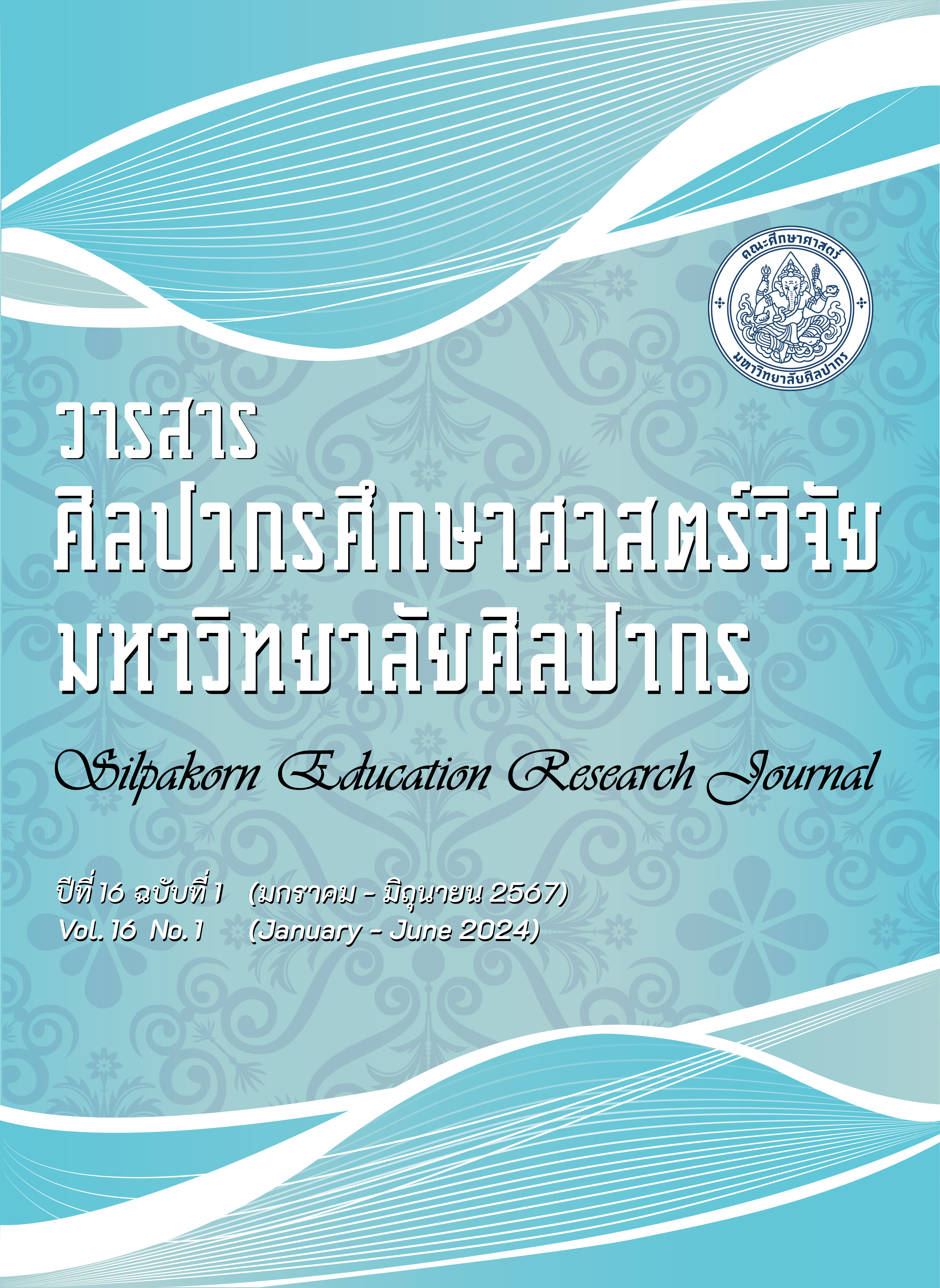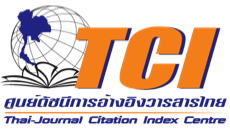ผลการจัดการเรียนรู้ด้วยวิธีเอสคิวโฟร์อาร์ร่วมกับแอปพลิเคชันที่มีต่อ ความสามารถในการอ่านและเจตคติต่อการเรียนวิชาภาษาไทย ของนักเรียนชั้นมัธยมศึกษาปีที่ 3
คำสำคัญ:
วิธีเอสคิวโฟร์อาร์, แอปพลิเคชัน, ความสามารถในการอ่าน, เจตคติต่อการเรียนบทคัดย่อ
การวิจัยนี้มีวัตถุประสงค์เพื่อ 1) เปรียบเทียบความสามารถในการอ่านของนักเรียนชั้นมัธยมศึกษาปีที่ 3 ก่อนและหลังการจัดการเรียนรู้ด้วยวิธีเอสคิวโฟร์อาร์ร่วมกับแอปพลิเคชัน 2) เปรียบเทียบความสามารถในการอ่านของนักเรียนชั้นมัธยมศึกษาปีที่ 3 หลังการจัดการเรียนรู้ด้วยวิธีเอสคิวโฟร์อาร์ร่วมกับแอปพลิเคชันกับเกณฑ์ร้อยละ 80 ของคะแนนเต็ม และ 3) ศึกษาเจตคติต่อการเรียนวิชาภาษาไทยของนักเรียนชั้นมัธยมศึกษาปีที่ 3 ที่ได้รับการจัดการเรียนรู้ด้วยวิธีเอสคิวโฟร์อาร์ร่วมกับแอปพลิเคชัน กลุ่มตัวอย่างคือ นักเรียนชั้นมัธยมศึกษาปีที่ 3 โรงเรียนวัดเขารวก จำนวน 34 คน ที่ได้จากการสุ่มแบบกลุ่ม เครื่องมือที่ใช้ในการวิจัย ได้แก่
1) แผนการจัดการเรียนรู้ 2) แบบวัดความสามารถในการอ่านจับใจความ และ 3) แบบวัดเจตคติ การวิเคราะห์ข้อมูล โดยใช้ค่าเฉลี่ย ส่วนเบี่ยงเบนมาตรฐาน การทดสอบค่าที กรณีกลุ่มตัวอย่างไม่เป็นอิสระกัน และการทดสอบทีกรณีกลุ่มตัวอย่างเดียว ผลการวิจัยพบว่า
- ความสามารถในการอ่านของนักเรียนชั้นมัธยมศึกษาปีที่ 3 หลังเรียนสูงกว่าก่อนเรียนอย่างมีนัยสำคัญทางสถิติที่ระดับ .05
- ความสามารถในการอ่านของนักเรียนชั้นมัธยมศึกษาปีที่ 3 หลังเรียนสูงกว่าเกณฑ์ร้อยละ 80 ของคะแนนเต็มอย่างมีนัยสำคัญทางสถิติที่ระดับ .05
- เจตคติต่อการเรียนวิชาภาษาไทยของนักเรียนชั้นมัธยมศึกษาปีที่ 3 อยู่ในระดับมากที่สุด
เอกสารอ้างอิง
Chureuk. (2008). Read Quickly to Understand the Issues. Bangkok: Se-Education. (in Thai)
Chusaengnil, C. (2019). Benefits of the Application. [Online]. Retrieved April 11, 2023, from https://www.scimath.org/article-technology/item/10115-2019-04-19-03-47-12. (in Thai)
Kulopas, T. (2018).Using the Mentimeter Program to Strengthen Adherence Classroom Relationships Among Graduate Students, Faculty of Education, Chulalongkorn University. Journal of Teaching and Learning Development Rangsit University. 12(2): 13-23. (in Thai)
Malaylohit, J. (2018). “The Effects of using SQ4R Instruction to Enhance the EFL Students Engling Comprehension at Thaksin University”. Inthaninthaaksin Journal 13(3): 213-227. (in Thai)
Meesuwan, W. (2019). “Developing Tangram Games with Augmented Reality Technology”. University Education Journal Naresuan University. 18(4): 56–86. (in Thai)
Noiphitak, R., Umkrai, J. and Aphirating, K. (2022). Synthesizing the Concept of Problem-Based Learning with Living Exercises (Liveworksheet) Mathematics Course Grade 5. At the 14th National Academic Conference Nakhon Pathom University. (1502–1516). Nakhon Pathom: Faculty of Science and Technology Nakhon Pathom University. (in Thai)
Pinturak, K. and Somphongtham, J. (2022). “Developing Reading Ability Understanding Thai Language using the SQ4R Technique for 3rd grade Students”. MCU Journal Ubon Paritharat 8(3): 1–16. (in Thai)
Rahma. (2018). The Implementation of SQ4R Strategy to Teach Reading on Descriptive for 8th Year Students of AMP N3 Getasan in the Academic Year of 2018/2019. English Education Department of Teach Training and Education Faculty. State Institute for Islamic Studies (IAIN) Salatiga. (in Thai)
Ramkhamhaeng University. (2019). Using Technology to Promote Learning in a Variety of Ways. [Online]. Retrieved April 9, 2023, from http://www.edu.ru.ac.th/images/edu_KM /km-poster-2562-03.pdf. (in Thai)
Rajapakdee and Inlam. (2020). “Results of Teaching and Learning using Padlet to Promote Self-Directed Learning Ability and Interaction Skills of Nursing Students in the Adult Nursing Course, 2 Topics: Nursing for Patients with Skeletal Problems. Udon Thani Hospital Medical Journal” 28(1): 52–60. (in Thai)
Rungviriyawong and Nillapun. (2018). “Developing Multimedia Reading Scripts using Data Local to Promote Reading Comprehension Skills for Grade 1 Students”. Silpakorn Educational Research Journal 10(1): 201–214. (in Thai)
Saenkhaew, P., Thammabut, B. and Thawongsa, K. (2022). “Improving the Reading Comprehension Ability of Secondary 4 students using the SQ4R Technique at Fang Wittayayon School, Ban Phang District, Khon Kaen Province”. Santayabhiwat Journal, Wat Nong Nok Kot 1(2): 33–51. (in Thai)
Salee, G., Suphakworakul, C. and Nachairit, D. (2023). “Activity Development Reading Comprehension in Thai According to the SQ4R Learning Concept for Secondary 2 students”. Journal of Education Maha Sarakham Rajabhat University 20(2): 106–115. (in Thai)
Sangyuenyong, S. and Paen Sri, A. (2020). “Improving Students' Spelling Skills Grade 4 uses the 4 Skill Ladder Learning Activities Together with the Application”. Academic Journal of Curriculum and Teaching Sakon Nakhon Rajabhat University 12(4): 73–80. (in Thai)
Sinthaphanon, S. (2011). Teaching Methods According to Educational Reform to Develop the Quality of Youth. Bangkok: 9199 Techniques Printing Stories. (in Thai)
Surathamjanya, R. (2017). “Results of using an Application for Teaching English Vocabulary on Tablets in the English Subject for Grade 2 Students under the District Office Ratchaburi Educational Area 2”. Journal of Humanities, Social Sciences and Arts, Silpakorn University 9(2): 1030–1045. (in Thai)
Walter, P. (1984). “The New SQ4R”. Journal World 23(3).
Yotharit, K. (2023). “Developing Reading Comprehension Abilities Using the SQ4R Technique with Mixed Media. of Students in Grade 3”. Journal of the Research and Development Institute, Maha Sarakham Rajabhat University 10(2): 231–242. (in Thai)





